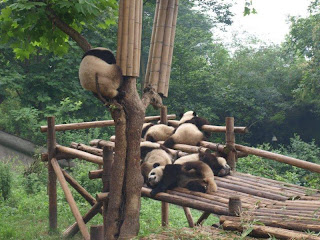.jpg) This isn’t so much a blog post as an excuse to post some cute pictures of panda bears. Yes, I’ve been visiting the panda sanctuary in Chengdu and have fallen for these big lazy puddings.
This isn’t so much a blog post as an excuse to post some cute pictures of panda bears. Yes, I’ve been visiting the panda sanctuary in Chengdu and have fallen for these big lazy puddings. .jpg) Pandas spend their lives either eating bamboo or sleeping and manage to cultivate a look that says ‘I’m seriously laid back’. They always find themselves a comfy spot and something to recline against seems to be an absolutely necessity. As they chew they occasionally reach lazily behind them for the next piece of bamboo. It reminds me of a person lying on a sofa reaching out for a handful of crisps while watching the telly.
Pandas spend their lives either eating bamboo or sleeping and manage to cultivate a look that says ‘I’m seriously laid back’. They always find themselves a comfy spot and something to recline against seems to be an absolutely necessity. As they chew they occasionally reach lazily behind them for the next piece of bamboo. It reminds me of a person lying on a sofa reaching out for a handful of crisps while watching the telly..jpg) They're so laid back they can hardly be bothered to mate and because they’re dependant on one food source they’re also very vulnerable when that food source becomes scarce for any reason. As a result, they’re an endangered species with only around 1500 remaining in the wild.
They're so laid back they can hardly be bothered to mate and because they’re dependant on one food source they’re also very vulnerable when that food source becomes scarce for any reason. As a result, they’re an endangered species with only around 1500 remaining in the wild. .jpg) The centre here is home to some 80 bears; it’s basically a one species zoo that has been very successful in breeding panda bears in captivity. Conservationists would like to see more effort made at improving habitats and growing wild populations and China is now starting to trial a reintroduction programme too; so far unsuccessfully.
The centre here is home to some 80 bears; it’s basically a one species zoo that has been very successful in breeding panda bears in captivity. Conservationists would like to see more effort made at improving habitats and growing wild populations and China is now starting to trial a reintroduction programme too; so far unsuccessfully. Other than Pandas, Chengdu is another big Chinese city – lots of traffic, lots of people – and after three days in the city I head off to my next destination, Xi’an; home to the Terracotta Warriors and a 20 hour train ride from Chengdu.
Xi’an is all concrete and high rise glass towers. I avoid the shopping malls and instead wander around the back streets, where I find a small market. Everywhere around me are men carrying small bamboo cages; they look like bird cages but are only a little bigger than a matchbox. They gather around an old man with a bicycle that seems to be singing and buzzing. I go closer. From every possible spot – the handlebars, the bar between the two wheels, the back carrier – hangs an impossibly balanced series of cages. The bike is piled 2m high or more with these tiny cages. The buzzing and humming is loud and insistent. I peer into the cages and find they are each home to an individual cricket. Around me men are bargaining hard, buying crickets and transferring them to their own cages. I ask why. They smile widely and mime a boxing fight. The crickets are apparently great fighters and these will be put to the test at local cricket fighting bouts. It’s a fight to the death and only one can be the champion.
Alongside the buzzing crickets, the highlight of my visit to Xi’an is the terracotta warrior museum. The effort that went into building this vast mausoleum is astounding.
 Thousands upon thousands of soldiers stand in regimented lines in a huge pit bigger than two football pitches. Each one is unique: unique face, unique stature (some are thin, others sport a beer belly) and each has unique details right down to their hairstyle and the tread on their shoes. So far three separate pits have been excavated; more are still being found.
Thousands upon thousands of soldiers stand in regimented lines in a huge pit bigger than two football pitches. Each one is unique: unique face, unique stature (some are thin, others sport a beer belly) and each has unique details right down to their hairstyle and the tread on their shoes. So far three separate pits have been excavated; more are still being found.All of this is part of the mausoleum of Emperor Qinshihuang; credited with unifying China in 200BC and infamous for his bad-ass ways (which apparently included burying the artisans that made the warriors alive so that their secrets couldn’t be revealed). The Emperor’s actual tomb has yet to be excavated. Archaeologists suspect that it is surrounded by a river of mercury (along with a very large cache of precious stones and gold) and they’re still working out a way to safely access it. Where is Indiana Jones when you need him?



No comments:
Post a Comment